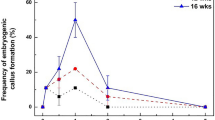Abstract
Methods were developed for the production of somatic embryos of asparagus (Asparagus officinalis L.) in suspension culture and subsequent conversion to plantlets on solidified medium. Stem-derived callus that was subcultured twice on Murashige and Skoog (MS) medium + 0.54 μM naphthaleneacetic acid (NAA) and 1.4 μM 2-isopentenyladenine (2iP) was used to initiate suspension cultures. Six out of 15 such cell suspensions (MS medium with 54 to 107 μM NAA) had a high embryogenic capacity. These cell suspensions consisted primarily of single elongated cells (about 90% of all single cells), embryogenic cell clusters (2571/ml), and globular translucent embryos (32/ml). The latter converted to plantlets within four weeks on embryo development medium (EDM), which was solidified MS medium containing 0.54 μM NAA and 0.98 μM 2iP. Suspension-derived embryos formed secondary globular embryos at high frequencies (251 to 258/g callus) when placed on EDM with a low carbohydrate (sucrose, glucose or fructose) level (2%). In contrast, EDM with a high carbohydrate level (10%) caused a reduction in the frequency of secondary embryos (30 to 85/g callus), while resulting in the promotion of embryo growth and conversion, 3.6 to 8.5 times higher than 2% carbohydrates. Transfer of globular somatic embryos from cell suspension to EDM with high carbohydrate levels (4 to 10%) for two weeks followed by transfer to EDM with a low carbohydrate level (2%) resulted in a 2 to 4 times higher conversion rate to plantlets than those that remained at the 4 to 10% levels.
Similar content being viewed by others
Abbreviations
- ANOVA:
-
analysis of variance
- EDM:
-
embryo development medium
- NAA:
-
naphthaleneacetic acid
- MS:
-
Murashige and Skoog
- RCBD:
-
randomized complete block design
- 2iP:
-
2-isopentenyladenine
- 2,4-d :
-
2,4-dichlorophenoxyacetic acid
- IAA:
-
indoleacetic acid
References
Ammirato PV (1986) Organizational events during somatic embryogenesis. In: Green CE, Somers DA, Hackett WP & Biesboer DD (Eds) Plant Tissue and Cell Culture(pp 57–81). Alan R. Liss, Inc., New York
Brown DCW & Thorpe TA (1980) Changes in water potential and its components during shoot formation in tobacco callus. Physiol. Plant. 49: 83–87
Brown DCW, Leung DWM & Thorpe TA (1978) Osmotic requirement for shoot formation in tobacco callus. Physiol. Plant. 46: 36–41
Crouch ML & Sussex IM (1981) Development and storageprotein synthesis in Brassica napus L. embryos in vivo and in vitro. Planta 153: 64–74
Fujimura T & Komamine A (1984) Fractionation of cultured cells. In: Vasil IK (Ed) Cell Culture and Somatic Cell Genetics of Plants, Vol 1 (pp 159–166). Academic Press, New York
Granatek CH & Cockerline AW (1978) Callus formation versus differentiation of cultured barley embryos: Hormonal osmotic interactions. In Vitro 14: 212–217
Guerra PM & Handro W (1988) Somatic embryogenesis and plant regeneration in embryo cultures of Euterpe edulis Mart. (Palmae). Plant Cell Rep. 7: 550–552
Kononowicz AK & Janick J (1984) The influence of carbon source on growth and development of asexual embryos of Theobroma cacao. Physiol. Plant. 61: 155–162
Levi A & Sink KC (1990) Differential effects of sucrose, glucose and fructose during somatic embryogenesis in asparagus. J. Plant Physiol. 137: 184–189
Levi A & Sink KC (1991) Somatic embryogenesis in asparagus: The role of explants and growth regulators. Plant Cell Rep. 10: 71–75
Linsmaier EM & Skoog F (1965) Organic growth factor requirements of tobacco tissue cultures. Physiol. Plant. 18: 100–127
Lu C, Vasil V & Vasil IK (1983) Improved efficiency of somatic embryogenesis and plant regeneration in tissue cultures of maize (Zea mays L.). Theor. Appl. Genet. 66: 285–289
Murashige T & Skoog F (1962) A revised medium for rapid growth and bioassays with tobacco tissue cultures. Physiol. Plant. 15: 473–497
Sharp WR, Sondahl MR, Caldas LS & Maraffa SB (1980) The physiology of in vitro asexual embryogenesis. Hort. Rev. 2: 268–310
Sharp WR, Evans DA & Sondahl MR (1982) Application of somatic embryogenesis to crop improvement. In: Fujiwara A (Ed) Plant Tissue Culture 1982 (pp 759–762). Maruzan, Japan
Steele RGD & Torrie HJ (1980) Principles and Procedures of Statistics. McGraw-Hill, New York
Steward FC & Mapes MO (1971) Morphogenesis and plant propagation in aseptic cultures of asparagus. Bot. Gaz. 133: 70–79
Wang YC & Janick J (1986) Sucrose concentration and osmolarity as factors affecting in vitro wax accumulation in jojoba embryos. HortScience 21: 1048–1049
Wilmar C & Hellendoorn M (1968) Growth and morphogenesis of asparagus cells cultured in vitro. Nature 217: 369–370
Author information
Authors and Affiliations
Rights and permissions
About this article
Cite this article
Levi, A., Sink, K.C. Asparagus somatic embryos: Production in suspension culture and conversion to plantlets on solidified medium as influenced by carbohydrate regime. Plant Cell Tiss Organ Cult 31, 115–122 (1992). https://doi.org/10.1007/BF00037695
Received:
Accepted:
Issue Date:
DOI: https://doi.org/10.1007/BF00037695




